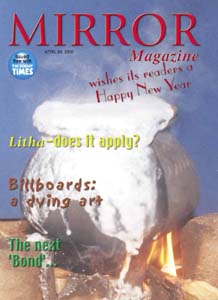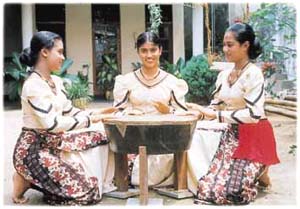
9th April 2000
News/Comment|
Editorial/Opinion| Plus| Business|
Sports| Sports Plus|










Keeping flicker of tradition burning
By Laila Nasry and Ruhanie Perera
Come April and Sri Lankans are busy, busy...all in preparation for the New Year. Even nature comes out in all its splendour with an abundance of fruits and flowers, with background music courtesy the 'koha'. Though
the Sinhala and Tamil New Year is a national festival with no religious
significance, it is steeped in tradition, passed down from generation to
generation. With extended families a dying phenomenon and time a scarce
commodity, one wonders if today's 'generation x' will know the joys of
hunching over a stove frying 'kavum', flying high on an 'onchilla' or giving
ear to a 'raban pade' instead of a hackneyed BSB CD.
Though
the Sinhala and Tamil New Year is a national festival with no religious
significance, it is steeped in tradition, passed down from generation to
generation. With extended families a dying phenomenon and time a scarce
commodity, one wonders if today's 'generation x' will know the joys of
hunching over a stove frying 'kavum', flying high on an 'onchilla' or giving
ear to a 'raban pade' instead of a hackneyed BSB CD.
The moment the New Year dawns is meticulously calculated to the last second by astrologers and 'auspicious times' set for every activity during the course of the day. The festivities do not begin till the end of a brief period where the stars change. This is called the "nonagathe"(punya kalaya), which is observed with prayer and worship. Next the hearth is lit and the milk boiled. This symbolises prosperity. Then the New Year dawns with a 'bang', with the lighting of crackers after which the family sits down to a meal of milk rice and sweetmeats. This is the first meal of the New Year.
Next the first financial transaction takes place while children take to their books -reading or writing - to guarantee a good year for education. Games such as "kotta pora", grease pole, "kamba adeema" and "banis kema" follow. Annointing oil is done at a specific time, generally a day later, followed by the first bath for the year. And so the traditions go, but how many of us actually adhere to them? For the younger generation is it a case of heading for the hills or making sure the swimming gear is packed for a vacation down south?
Kanishka Hewage believes that if one is observing traditions, it should be done to the letter. "Honestly I do not observe all the traditions. I do not wear the auspicious colour or engage in all the customs. The most we do at home is light the hearth, which inevitably is the gas stove and partake of the traditional kiribath and sweetmeats. Then we head for Nuwara-Eliya for the long holiday. This year would be no different."
"For our family the avuruddha, is the new year. Though we don't celebrate every single tradition like the 'thel gama' we do keep to the main ones like going to the temple during the "punya kalaya", lighting the hearth, wearing the specified colour, the first 'ganudenu' and visiting relatives," says Radhini Fernando who enjoys traditions. "I can't wait for March to fly by and the New Year to dawn. I think it's a great time for families, you can put aside your differences and get together. Those who don't really celebrate 'avurudhu' are missing out on so much. Seeing everyone gathered at the temple at the same time creates this feeling of inner peace and solidarity."
For Indrika Gooneratne "traditions are the most important thing about avurudhu. It's important to keep traditions alive and we stick to everything. There's no point in doing something half-heartedly".
Indrika remembers a time when she "joined up with relations and all the friends down the lane and had our own celebrations. We dressed up weirdly and had a twisted version of 'avurudhu kumari'. The main event was 'banis kema'. It may seem kiddish, but it kept us together and that togetherness is still there. That I think is the most important part of the New Year".
"April is 'time to go to Nuwara - Eliya' for me," says Asanga Warnasuriya, whose family does celebrate avurudhu. "But we don't observe all the rituals and we don't stick to the auspicious times. Yet, we do have the first meal and visit relatives on that day. It's like a day to meet all the cousins you won't see again until the following year."
Avurudhu is a time for family reunions, but according to Asanga, "there shouldn't have to be a time for reunions, you should meet up anyway".
To some of us avurudhu is just a long weekend, a time for a holiday. But to others it is the beginning of a New Year. A time when the everyday chaos comes to a standstill and each person is left with the things most important to him/her. It is a time to just sit back and take a moment for yourself. It may not be celebrated by everyone with the same fervour, yet it marks a new beginning...new hope.
It's that time of year
Kokis1/2 measure rice-flour
2 teacups coconut milk
1 tbs sugar
2 eggs
salt
oil for frying
Put the flour, sugar and salt into a basin, add half the milk and mix to a smooth paste. Beat eggs and add to the batter and add the rest of the milk gradually. Beat until perfectly smooth, and to be thicker than a pancake batter. Take a kokis mould and dip into a deep pan of boiling coconut oil. Then dip into the batter, taking care not to let the batter cover more than three parts of the mould. Plunge it into oil and fry. Slip the kokis out of the mould by shaking it a bit and let it fry a bit more to brown the inside. Drain on paper.
Approx. cost - Rs. 50
Aluva
1/2 measure well-roasted and sieved rice-flour
1/4 measure coconut syrup
25 cadjunuts
pinch of roasted and powdered sweet cummin
1/2 tsp ghee or butter
salt
Put the syrup into a pan and stir over the fire until it thickens. Then add the flour, reserving about 1/4 of it for coating the aluva, and stir well and briskly. Mix in the cadjunuts cut into pieces, cummin, salt and ghee. Mix all together and turn quickly on to a floured board. Knead by hand and flatten, coating the top with flour. Cut into diamond shaped pieces.
The flour should not be allowed to boil too long in the syrup as that makes the aluva sticky.
Approx. cost - Rs. 100
Bibikkan
1/2 measure rice-flour
1 lb finely scraped coconut
3/4 lb jaggery (scraped)
2 oz moong-atta
salt
a pinch of carbonate of soda
Mix the flour, coconut and jaggery in a basin, adding salt to taste. Then add the moong-atta slightly roasted and husked, and the soda, and mix well together. Place a round of plantain leaf in the middle of a hopper pan, pour a spoonful of the batter into it, cover with a chatty containing burning coals and bake till done.
Approx. cost - Rs. 150
Konda Kavum
1 measure rice-flour
1/4 measure coconut syrup
salt
oil for frying
The flour must be very finely sieved. Put it into a basin, add the syrup and mix well together, adding a little salt and a little hot water, if the batter is too thick. Have ready a deep round-bottomed pan of boiling coconut oil. Pour in a spoonful of the batter and as it begins to fry and the centre rises, pour in a little more batter into the centre and insert an ekel in the middle of the fritter, not allowing it to go through. Keep twising the ekel round and round at the same time splashing boiling oil on the fritter using an oil spoon for the purpose. This is to produce the konde. Press round the base of the konde with the spoon to get it into the proper shape. The kavums must have a nice brown colour when fried. Drain well.
Approx. cost - Rs. 100
Return to Mirror MagazineContents
![]()
Front Page| News/Comment| Editorial/Opinion| Plus| Business| Sports| Sports Plus| Mirror Magazine
Please send your comments and suggestions on this web site to


